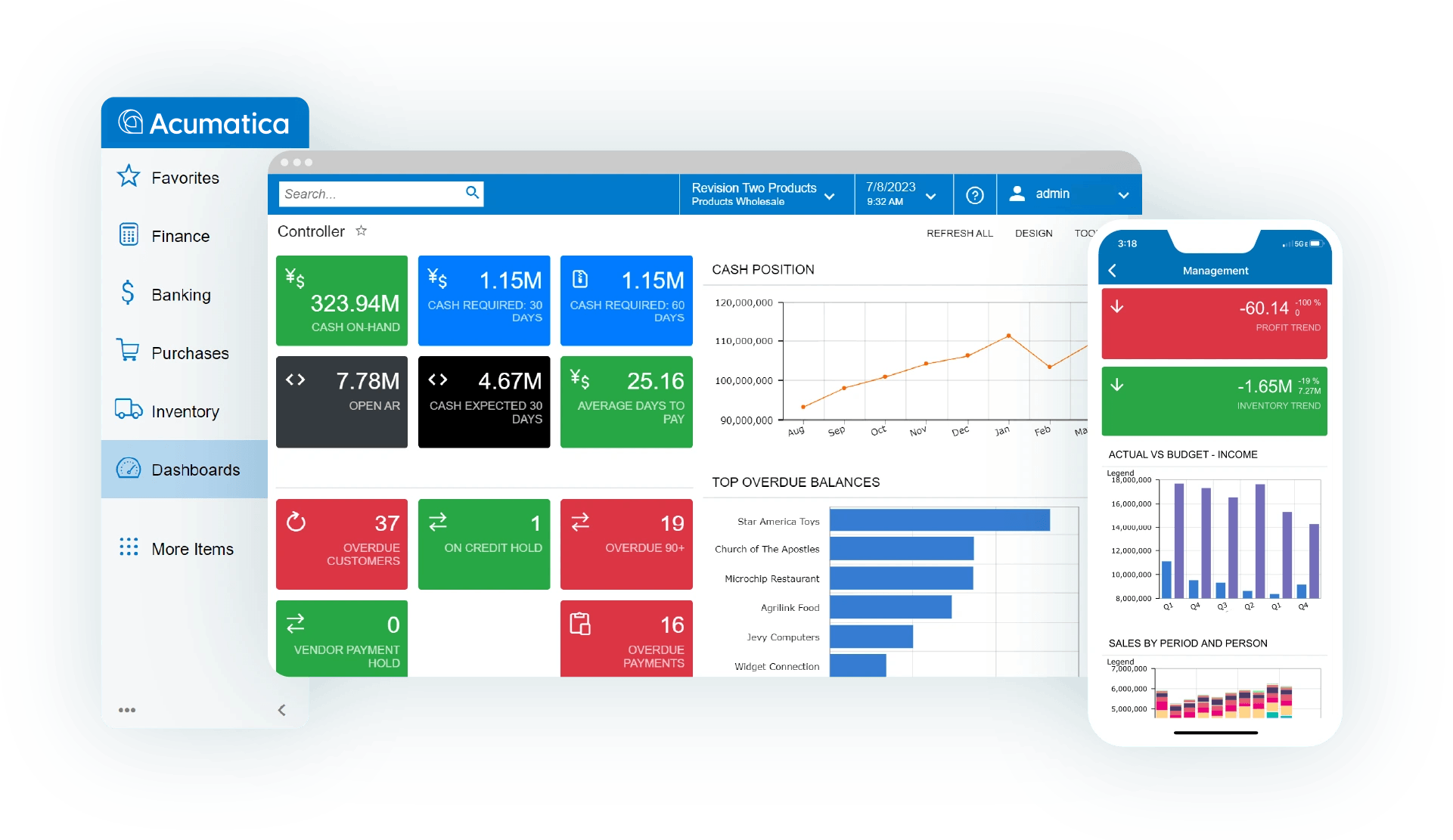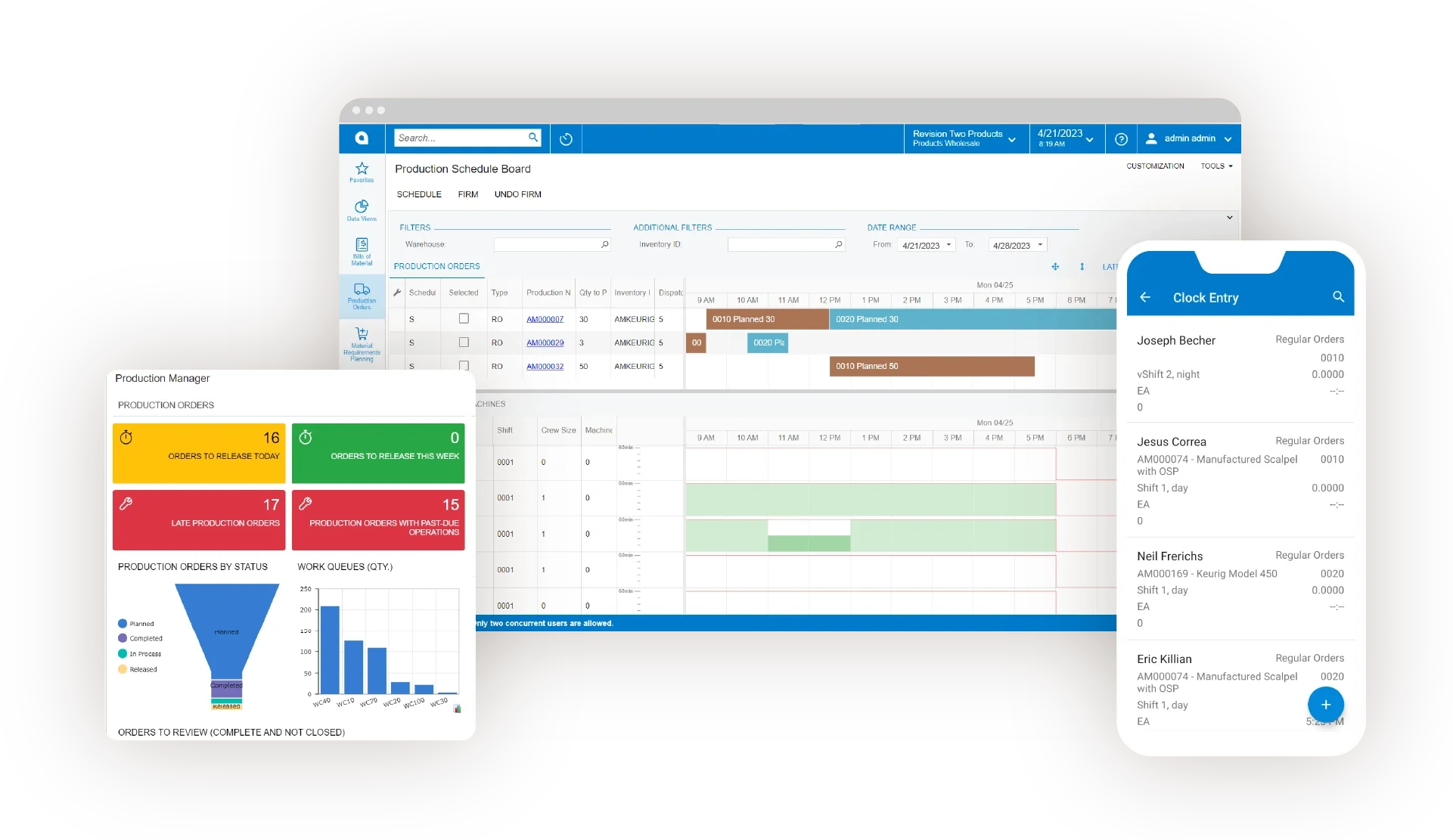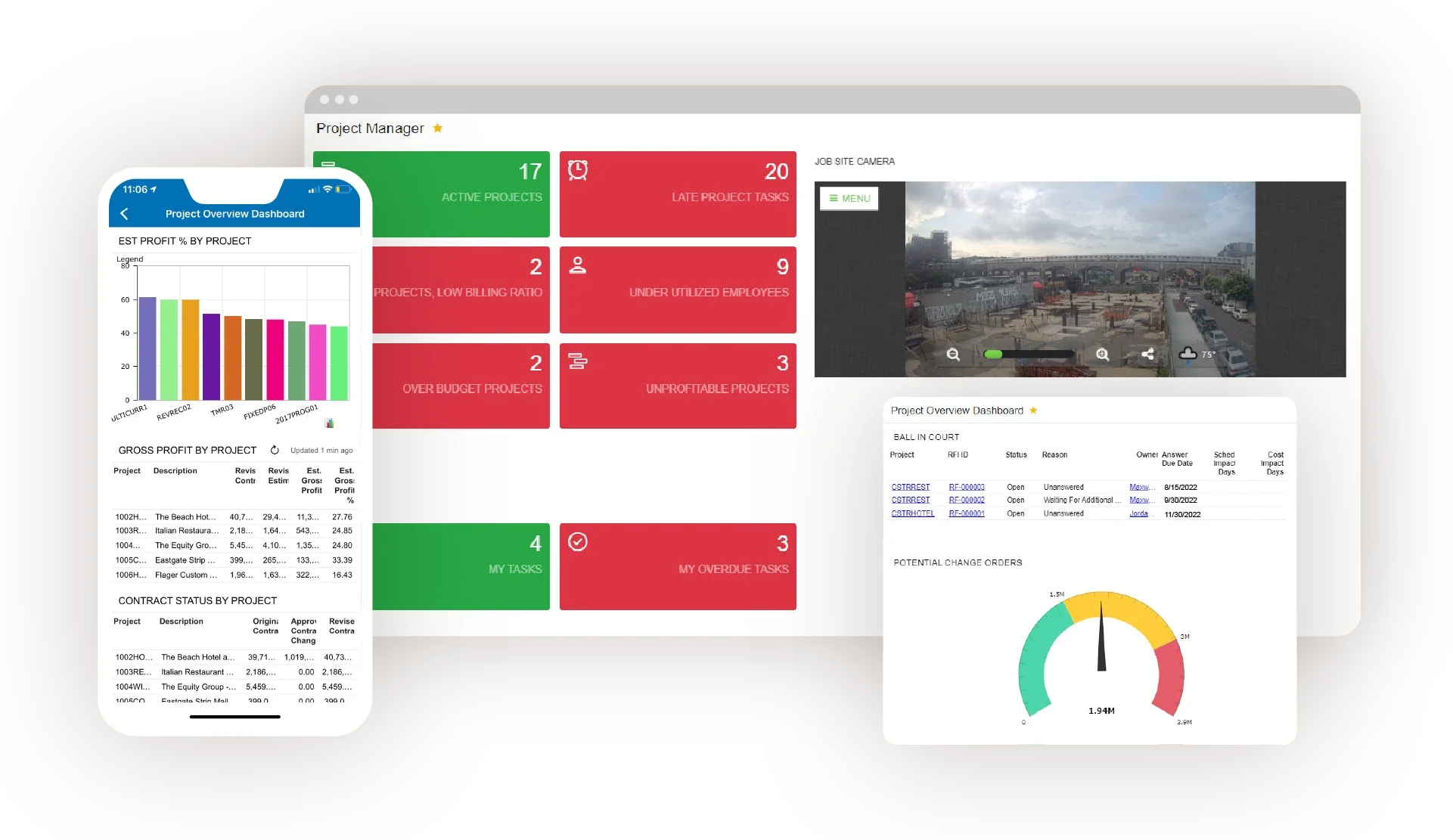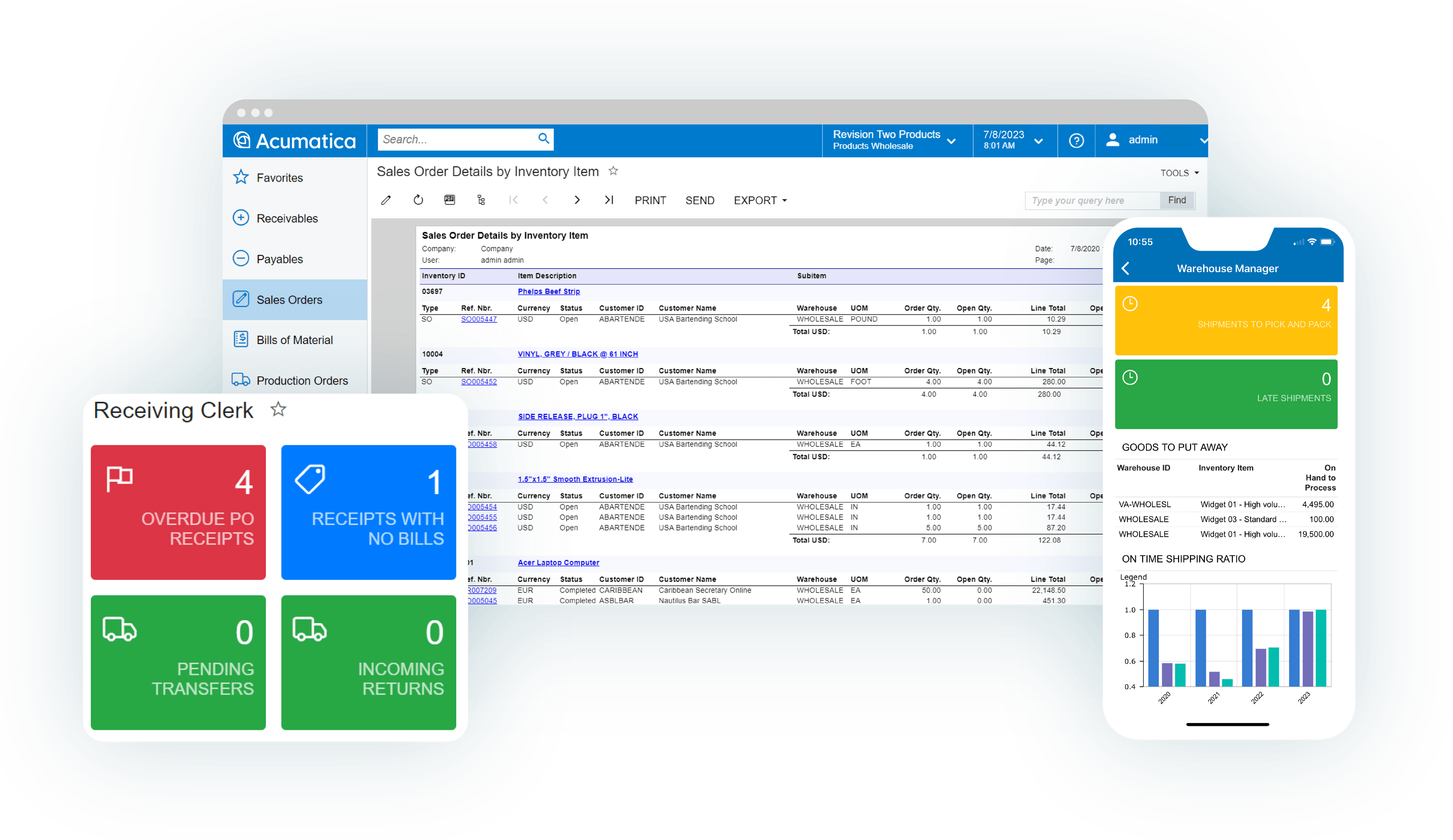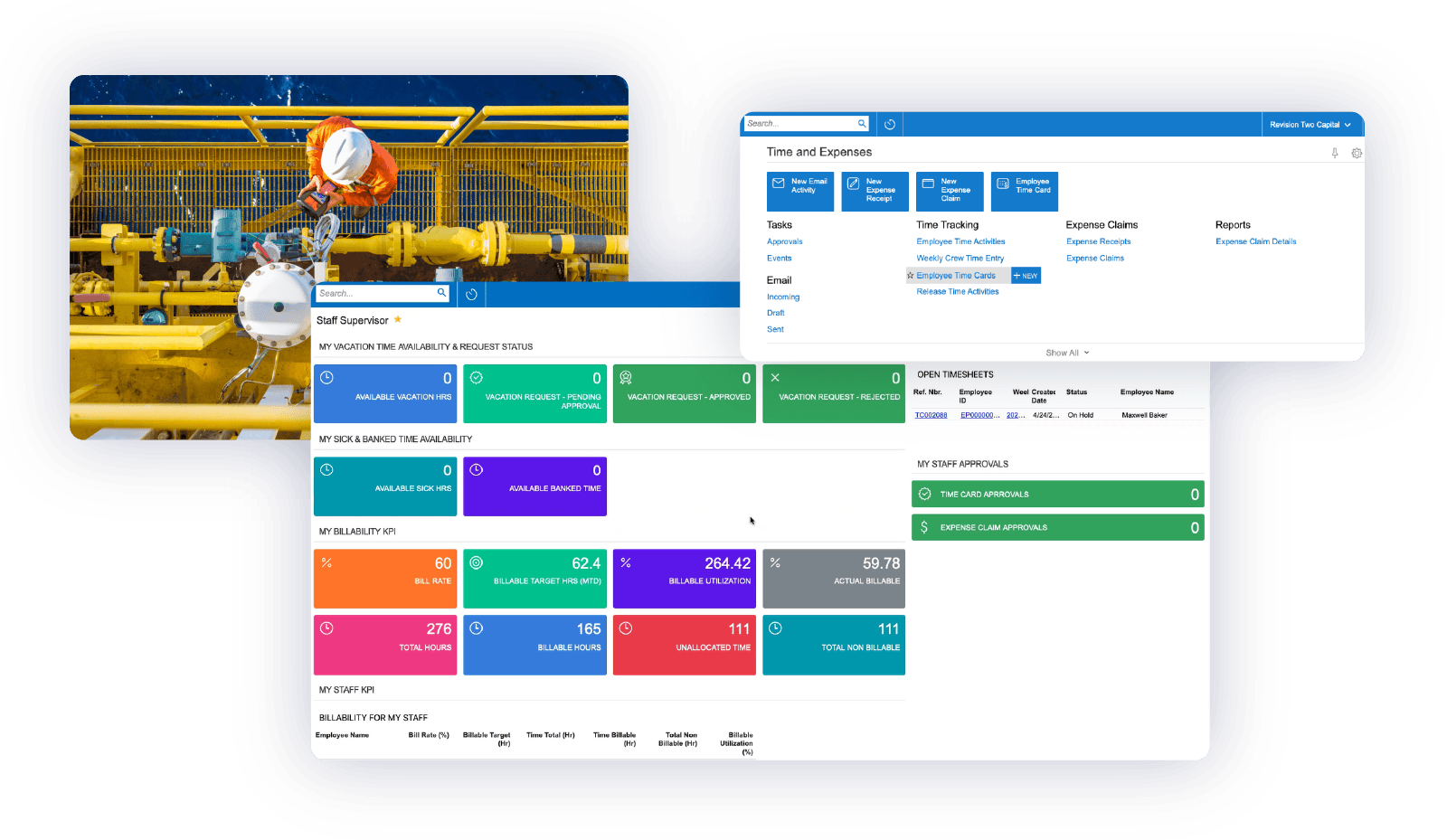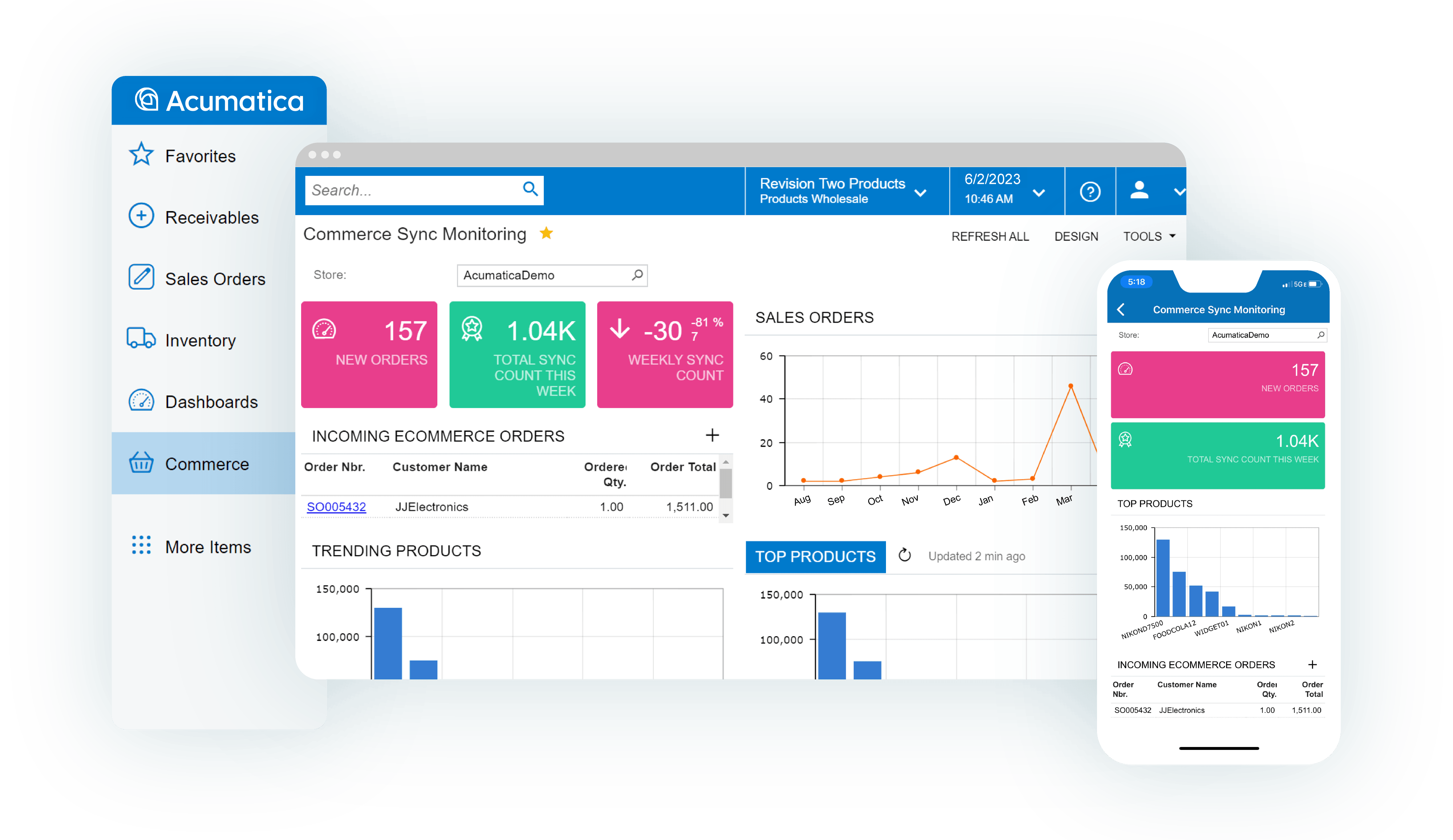A full suite of accounting functions and reporting tools, to meet the needs of growing companies.
Acumatica Cloud ERP Software
General Business
Manufacturing
Construction
Distribution
Professional Services
Retail
General Business
Put your whole business at your fingertips.
With real-time access to financials, reporting, CRM, and more, our integrated business management solution was specifically designed to help small and mid-market businesses thrive in the new digital economy.
Explore General BusinessManufacturing
An intuitive Cloud ERP system designed for manufacturing businesses.
A complete manufacturing business system that supports multiple manufacturing methodologies, including make-to-stock, make-to-order, engineer-to-order, project-centric, job shop, batch, and repetitive manufacturing.
Explore ManufacturingConstruction
Built for today’s complex and connected construction industry.
Construction software that tracks projects in real-time, eliminates costly delays, automates workflows to increase collaboration, streamlines communication, and allows for the whole team to log on anytime, from anywhere.
Explore ConstructionDistribution
Distribution ERP for modern supply chains.
An intuitive wholesale distribution ERP system providing unparalleled distribution depth with an extensive suite of connected distribution applications for sales, inventory, purchasing, and warehouse management.
Explore distributionProfessional Services
A complete professional services ERP software for project-centric firms.
Our innovative professional services product is designed for project collaboration and built to meet today's challenges and seize tomorrow's opportunities.
Explore Professional ServicesRetail
Give your customers a superior experience.
Discover operational excellence with a complete retail ERP system for inventory accuracy, omnichannel fulfillment, perfect order rates, and seamless customer communication.
Explore RetailGeneral Business
One complete system to run your business: Financials, Project Accounting, CRM, and Reporting, Business Intelligence, and more.
Know the actual costs of internal or external projects. Manage budgeting, time sheets, project inventory, and complex billing. Project reporting lets you compare actual project costs with original and revised budgets using visual dashboards.
Reduce staffing costs and increase accuracy with a complete payroll management solution for your entire company.
Streamline accounting and reporting across multiple entities, and dramatically reduce errors and inaccuracies in financial statements.
Gain greater insights into your organization with self-service tools from Acumatica to generate reports and analyze trends easily and in real time.
Includes standard CRM functionality for managing leads, contacts, opportunities, and more. In addition, post-sales service and customer portals help improve the total customer experience.
Manufacturing
A complete Cloud ERP suite for manufacturing includes core manufacturing, distribution, financial, and reporting applications with optional, connected applications to tailor the system to your unique business needs.
Efficiently plan and manage inventories, costs, and manufacturing processes as well as full revision control. See both engineering and financial views of product structure in the multi-level Bill of Materials software (BOM)/Routing.
Manage production orders, release and schedule orders for the shop floor, and track material and labor costs. Compare standard and planned production costs to the actual costs of the production order.
Generate time-phased manufacturing and purchasing plans for optimal inventory availability tied to forecast and customer demands.
Meet customer demands by setting accurate and reliable delivery dates using visual scheduling with Acumatica’s Advanced Planning and Scheduling.
Manage version control and updates to bills of material (BOM) and routings while controlling effectivity dates that impact material planning, costing, and scheduling.
Print barcodes and utilize scanners to capture data from the shop floor including labor and material transactions and inventory movement.
A multi-level, dimensional, rules-based system with non-hierarchical feature selections and configuration evaluation. Use on quotes, sales orders, and/or production orders with real-time price and cost rollup.
Create estimates for new or existing items. Convert estimates into bills of material, production orders, or other estimates.
Construction
Acumatica’s true Cloud ERP Construction Management software is built to equip construction firms with powerful business intelligence—because visibility drives success.
Acumatica’s Cloud ERP Construction Management software is built to equip construction firms with powerful business intelligence—because visibility drives success.
Make the most of every type of construction project, stay on schedule, manage job costs, and achieve greater profitability.
Manage your customers, subcontractors, and every aspect of the home building process with ease and complete control.
Seamlessly link the field and office to capture and manage labor, material costs, and inventory for plumbing, electrical, HVAC, masonry, carpentry, and other specialty trade contractors.
Manage your projects with ease and maintain complete control—from excavation through infrastructure.
Maximize dispatching and boost revenue by scheduling the right people at the right time, and see real-time data for work taking place in the field.
Tracks all products related to your customer and schedules preventative maintenance. Sold as a separate application.
Distribution
Distributors of any size face many of the same global challenges, but also have unique needs for their individual markets. Acumatica allows you to implement a highly flexible and fully functional distribution solution at a lower total cost.
Optimize sales order entry and fulfillment. Split orders across multiple warehouses, allocate inventory, verify credit limits, issue replenishment orders, accept returns, and more. Improve processes and avoid delays through integrated workflow with notifications and alerts.
Reduce costs and improve vendor relationships by automating and centrally managing your global purchasing processes. Acumatica’s online sourcing automates the entire procurement process from vendor quotes to paying invoices.
Streamline warehouse operations and transactions to reduce errors, automate processes, and increase productivity.
Simplify your inventory processes with flexible item management, quality traceability, and robust replenishment to balance supply and demand. Optimize stocking levels to avoid rush orders and stock-out situations with increased inventory turns and lower carrying costs.
An integrated order management solution empowers companies to streamline processes and get the visibility they need to make smarter, faster business decisions.
Organize and simplify complex distribution processes involving multiple products and suppliers. Optimize the way you gather requests, obtain bids, create quotes, approve quotes, manage purchases, and fulfill orders for internal or customer needs.
Retail
Multi-channel retail and eCommerce software solution for small and midsized companies that improves the in-store experience and automates how online sales orders are entered and fulfilled.
Acumatica’s native integrations with Amazon, BigCommerce, and Shopify enable you to connect your eCommerce storefront with Acumatica’s financials, inventory, product information, and fulfillment—in real time.
Simplify your inventory processes with flexible item management, quality traceability, and robust replenishment to balance supply and demand. Optimize stocking levels to avoid rush orders and stock-out situations with increased inventory turns and lower carrying costs.
Optimize sales order entry and fulfillment. Split orders across multiple warehouses, allocate inventory, verify credit limits, issue replenishment orders, accept returns, and more. Improve processes and avoid delays through integrated workflow with notifications and alerts.
Gain greater insights into your organization with self-service tools from Acumatica to generate reports and analyze trends easily and in real-time.
Streamline warehouse operations and transactions to reduce errors, automate processes, and increase productivity.
Rapidly respond to customer requests, streamline the customer journey, and improve the overall customer experience with Acumatica’s CRM software. Capture all marketing, sales, billing, finance, and customer data in one solution, right at your fingertips.
Professional Services
Empower your team with a flexible and comprehensive professional services solution, crafted for seamless project collaboration and designed to help you overcome today’s challenges while preparing for future opportunities.
Know the actual costs of internal or external projects. Manage budgeting, time sheets, project inventory, and complex billing. Project reporting lets you compare actual project costs with original and revised budgets using visual dashboards.
Ensure resource availability to accurately allocate staff, equipment, and technology by team, department, and timeframe.
Includes standard CRM functionality for managing leads, contacts, opportunities, and more. In addition, post-sales service and customer portals help improve the total customer experience.
A full suite of accounting functions and reporting tools, to meet the needs of growing companies.
Streamline payment processing and reduce back-office workloads with an integrated payment solution.
Gain greater insights into your organization with self-service tools from Acumatica to generate reports and analyze trends easily and in real time.
Join 10,000+ businesses like yours thriving with Acumatica





 Canada (English)
Canada (English)
 Colombia
Colombia
 Caribbean and Puerto Rico
Caribbean and Puerto Rico
 Ecuador
Ecuador
 India
India
 Indonesia
Indonesia
 Ireland
Ireland
 Malaysia
Malaysia
 Mexico
Mexico
 Panama
Panama
 Peru
Peru
 Philippines
Philippines
 Singapore
Singapore
 South Africa
South Africa
 Sri Lanka
Sri Lanka
 Thailand
Thailand
 United Kingdom
United Kingdom
 United States
United States
